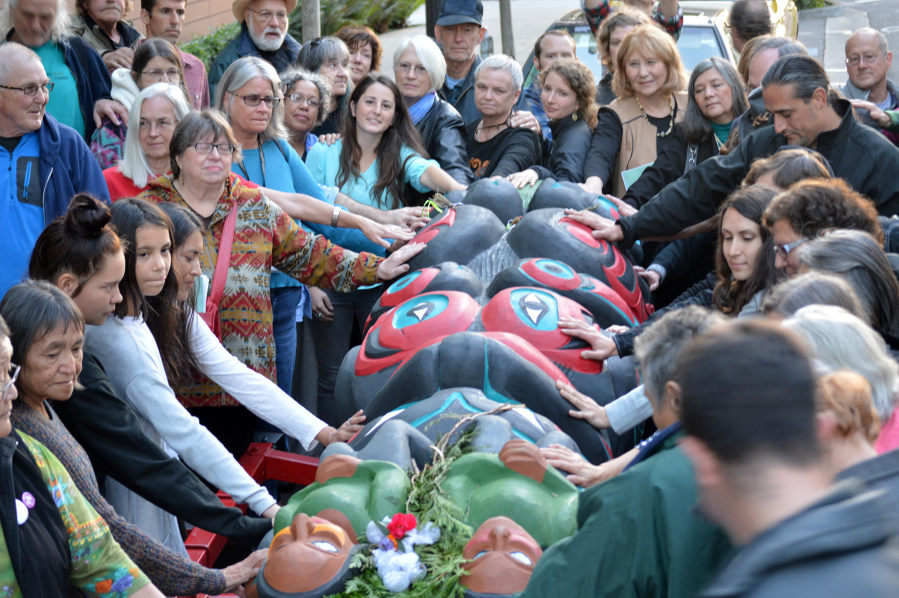A totem pole carved and put on tour to bring attention to the potential risks fossil fuel pipelines and shipping terminal projects present to Native American communities, and how climate change threatens the world at large, made a stop in Vancouver on Monday night.
The pole is a symbol of tribal resistance to the oil terminal project proposed at the Port of Vancouver, the Millennium Bulk Terminals coal export proposal in Longview and the methanol refinery proposed for Kalama by Northwest Innovation Works, according to Columbia Riverkeeper, an environmental organization that helped organize Monday’s event.
Guests came to the Vancouver Community Library and joined a blessing and a presentation about the project.
Jewell James, head carver with the House of Tears Carvers group and part of the Lummi Treaty and Sovereignty Protection Office, said the totem poles are a means to protest and to raise awareness for different causes.
Lummi Nation members are traveling across the country with the totem pole to draw attention to proposed fossil fuel export terminals, pipelines and other facilities and their potential environmental impacts.
“We can’t do it alone, so we had to figure out a way to draw the attention of churches, citizens groups, environmental groups and other tribes, and so we developed the totem pole journeys, started advocating that all of us have to work together,” he said.
The tour stops at the Ecotrust Building in Portland today, and finishes Oct. 25, as part of an exhibition at the Carnegie Museum of Natural History in Pittsburgh called “Kwel’Hoy, We Draw the Line!”
The exhibit will join a conference and larger exhibition focused on the modern humanity’s toll on the natural world, defined by some scientists as a new geological epoch: the Antropocene. Afterward, the pole will go on a nationwide tour.
James said carvers started work in April, and just barely finished when they put it on the trailer for its trip east. They’ve carved several other poles for different causes, said his brother Douglas James (also Sit-ka-kadem), who’s helping on the trip.
Their first pole, he said, was to memorialize the Sept. 11, 2001, attacks, and people responded profoundly.
People came and laid their hands on the pole, he said, and you could see tears in their eyes.
“This is just an object that we’re using. The pole is not sacred,” he said. “What’s sacred is you people that come here to pray together, is what’s sacred. Your prayers are what’s sacred.”
They made poles for the Flight 93 crash site in rural Pennsylvania and Pentagon as well, he said, and the project carried over.
The top of the pole shows a Native American man in the moon, sitting in front of a fire with his legs crossed, hands in his lap and head bowed in prayer for the protection of the Earth, Jewell James said.
Below that, there’s a few humans, all painted the same save colored stripes to represent the different races, James said, “because really we’re all the same when it comes to the destruction of the Earth.”
The base of the pole depicts a large bear from a story of a bear that damaged the fishing in a river by getting too greedy and feeding in the salmon’s spawning grounds, James said.
“We do have legends and myths, stories, about how we had damaged the environment and we had suffered famines because of it,” he said. “But over millenniums we learned to live with nature and teach our children to have respect for it.”




